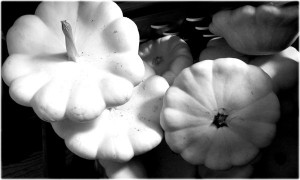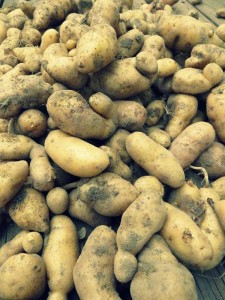Root cellaring is a popular way to store food over the winter, but several equally efficient alternative food storage systems are available to those of us who live on foundations, or in apartments and condos.
Indoor, in-place and buried container food storage systems are practical and affordable ways everyone can store food. But depending on the foods you plan to store, some alternative food systems create better storage conditions than others. Before choosing an alternative system, consider the storage conditions your food requires:
- Cool, moist conditions: carrots, parsnips, cabbages, beets, radishes
- Cool, dry conditions: onions, garlic
- Warm, moist conditions: sweet potatoes
- Warm, dry conditions: potatoes, pumpkins, winter squash
Indoor storage
Indoor storage is the easiest and most obvious alternative system. It costs nothing. All you have to do is identify existing areas of your home with ideal food storage conditions and use them to store food.
Some homes without basements have a cool, moist crawl-space, perfect for storing carrots and parsnips. Pack produce in breathable bags and then load into wooden crates. Cover with a lid to keep pests away.
Shutting the vents and sealing off a spare room or closet in your apartment creates cool, dry conditions to store food.
Warm, moist conditions can be achieved by wrapping sweet potatoes in newspaper and packing in insulated coolers. I keep ours under the stairway in our house, but the garage is also a good idea.
Attics and furnace rooms are warm and dry — perfect for potatoes and pumpkins. One winter we emptied the bookshelves in our furnace room and filled them with winter squash.
In-place
In-place alternative food storage systems require a few simple tools and supplies, but are still efficient and economical alternatives to root-cellaring. For detailed design graphics download a free copy of Washington State University Extension bulletin EB1326, Storing Fruits and Vegetables.
Three in-place alternative food storage methods that may work for you are mounding, hay-bale and tent.
Mounding stores produce in insulated pockets beneath layers of straw and dirt. Each pocket is vented for air circulation. A drainage trench helps control moisture. You must remove all food at once, so store food in several small lots. Foods requiring dry storage conditions like potatoes and onions do well under mounds.
Hay-bale storage builds a bale structure around planted garden rows. Recycled storm doors or large pieces of Plexiglas should be set on top of the bales to create a cold frame. You can cover the glass with a tarp or blanket during extreme winter weather to add extra insulation. Unlike mounding, hay-baling allows you to harvest food as needed. Hay-baling works best for cool, moist crops like carrots, beets and radish.
Mini hoop-houses made from PVC pipe and a thick layer of clear plastic are be used to tent garden rows. If you are willing to put in the effort to build the structures, blueprints are free online, and materials are very affordable. If you grow food in shared garden space, building the mini hoop-houses with other gardeners is a fun and healthy community project. You can use the structures most of the year: as a food storage system in winter, a seed starting/ hardening tool in early spring, and to extend the season in fall. This method works well for cool, moist crops.
Buried container
Buried container food storage system creates a mock root cellar underground. First drill holes in the bottom of barrel sized container with a lid. Dig a hole deep enough for a 4” inch rock drainage layer plus the size of the container. Bury the container, leaving only 2” inches above ground. Fill the container with layers of food, separated by straw. Top the container with a lid and then cover it with 1-2’ feet of straw. Harvest produce as needed. This system works great for root vegetables.
Related: Building a root cellar













